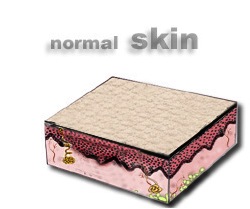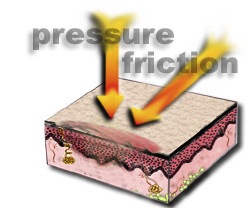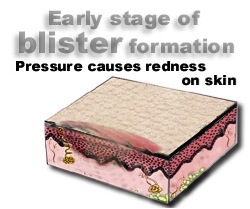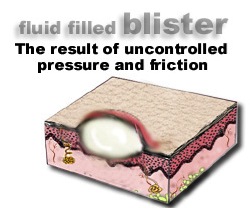What Do About Blisters
By Jon Scarlet, DPM
Former
- – Head Podiatrist for the Boston Marathon
- -Chief of Podiatry at the University of Massachusetts Medical Center
- -Member of the American College of Sports Medicine
First let’s understand that anything under our skin (in our bodies) is sterile – no bacteria, no contamination. Anything on the outside of our skin is alive with bacteria and thus by medical definition -contaminated. Hey, that’s the real world. And we’ve been doing just fine with that for several million years. We’ll of course exclude from this discussion the mouth, digestive tract and the intestines which are full of billions of bacteria. But those body parts cleverly make up their own walled-off tube. So unless we get very sloppy, bacteria in those places just stay put.
So if you get a blister your first goal is to keep it from opening. That way whatever dirt or bacteria are on the outside of the skin won’t get inside the skin to cause an infection. By the way one definition of an infection is a condition where bacteria grow past the point that normal body defenses can stop them.
Well just what is a blister? A blister is a fluid filled bump that happens when skin is subjected to rubbing or pressure. We can often tell when it’s starting because there is localized pain in one small area – a so-called “hot spot” If you feel this happening STOP IMMEDIATELY AND DO SOMETHING. What should you do? Here are some suggestions:
- -Change socks (you do carry an extra pair, don’t you? and they of course are not made out of cotton)
- -Retie your shoes (looser or tighter)
- -Change your walking pattern (use longer or shorter steps)
- -Apply protective padding (more on that later)
- -Go home
- -Have your buddy carry you (PCMSC club members are really friendly)
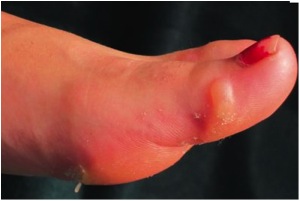
As soon as we feel any irritation or pain a blister is forming. Friction causes the top layer of skin to separate from the deeper layers. Fluid (serum) then quickly fills the space between these layers. The stages in blister formation are pictured here:
As a member of the Park City Mountain Sports Club you are, by definition, extremely intelligent and resourceful. So you are, of course able to prevent and if necessary properly treat blisters. Here’s what you most likely will do to handle blisters.
- First do the preventative things mentioned above.
- If you carry any sort of padding here’s how to apply it. (Never use circular/donut shaped adhesive pads. They only concentrate unwanted pressure in the donut center and make things worse.) It’s a good idea to carry such pads with you. The trick is to cut them in half into ‘U” pads and place the “U” around the bad spot (the red spot or the blister). Be sure the pad is thicker than the blister. Double it up if necessary.
- Cover it with antibiotic ointment and a band-aid. This will keep the area moist and provide a cleaner region if the blister breaks.
- When you get home wash the area and re-bandage it with the same pressure protection stuff as you may have done on the trail.
- Do that daily until there is no more pain, redness or evidence of a tense fluid-fill bump.
The body will safely absorb the contents of the blister if the skin over the blister is not open.
What to do if the blister breaks
If, as Chicken Little feared, the sky does fall and the blister breaks you have a condition similar to what you would have if you had a shallow cut on your skin. So let’s review common first aid for that eventuality. The makers if antibiotic ointments want us to use that product for every cut. WRONG. If you are a generally healthy person with a normal ability to fight off infection then using antibiotic medication for every cut is just giving you skin bacteria practice in learning how to overcome the stuff. When that happens and you someday need that medicine the bacteria on your skin could well be immune to it.
What to do? Know that Iodine kills almost all bacteria. The best stuff to keep around the house (and in a tiny plastic bottle in your hiking pack) is something called 10% Povidone Iodine. The Iodine we used as kids was in an alcohol solution. It actually was the Alcohol which caused all that burning we vividly remember. When Iodine is dissolved in water (Povidone-Iodine) it produces very little burning. It just kills bacteria. (It’s also used by surgeons for hand scrubbing before surgery in almost every hospital in world). It is not a complex antibiotic that the bugs can learn to live with. It is very cheap in the generic form –which is as good as the brand name stuff “Betadine” .
So wash the injured part in Povidone-Iodine and cover with a sterile dressing – bandaid or gauze and tape if the area is larger. Povidone-Iodine also comes in an ointment. That may be more comfortable to use, eventually the thin skin that was the top of the blister will look and feel like the stuff that peeled when a bad sunburn was healing. When that tissue is painless to touch, in 1-3 days, it can be safely cut away.
When redness, pain and loose skin are gone, you are done and ready to insult the body once more. If pain and redness don’t improve, an infection could be present, and professional help may be needed.
